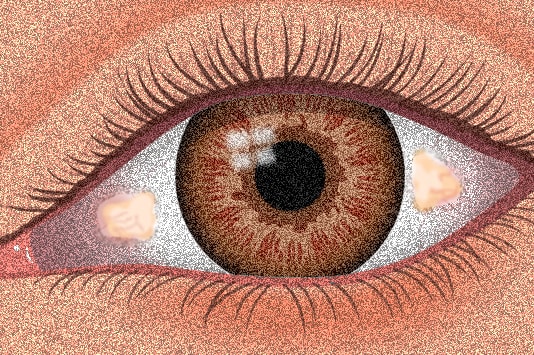By Kathy Batesel
Pinguecula, pronounced pin-gweh-kyoo-luh, is an uncommon word, but it denotes a condition many adults will develop during their lifetimes.
If visiting an optometrist or ophthalmologist isn’t on your annual to-do list, you may be left in the dark about this common affliction.
So, what the heck are these things?
Pingueculae are blister-like, elevated bumps just outside the cornea on the exposed white areas of the eye. They aren’t blisters, however. Without getting too technical, they are the result of fatty tissue breaking down and being replaced by stronger fibrous material (Oh dear!).
In some cases, these non-cancerous masses can grow into the corneal area, creating a condition called pterygium that can affect eyesight. They may appear yellowish, gray, or have little or no color at all.
Doing a number on your eyes…
While there is no definitive research on the causes, pinguecula are attributed to repeated exposure to certain irritants. Growths occur on the exposed whites of the eyes, particularly where sunlight may be reflected off a person’s nose.
In addition to sunlight, wind and other environmental conditions may contribute to pinguecula development. Arc welding, farming, frequent tanning – even surfing – are all thought to increase one’s risk of developing the disorder. Although most commonly seen in people over 40, growths may appear as early as the mid-20s.
Symptoms caused by a pinguecula are often mild, but can cause patients significant emotional distress because it permanently changes their appearance and may make them look tired or ill if blood vessels become more noticeable due to the growth.
Patients may also notice dryness and itching. Hyper-pigmentation (permanent darkening) of skin and/or hair often occurs in the same patients as well, though the two conditions aren’t directly related to each other.
So what do I do about this?
While optometrists and ophthalmologists are more likely to discuss the condition with their patients, many general practitioners won’t even mention a pinguecula because the symptoms tend to be mild, the mass is expected to grow slowly over a period of years, and there are few treatment options.
Artificial tears can help with itchy, dry eyes. Anti-cancer ointments like mitomycin-C can slow growth. Surgery can remove a mass, but is costly (up to a few thousand dollars per eye) and recurrence is possible.
Sunlight reflections off water, metal, or snow, black lights, and tanning beds all direct UV light to your eyes. To protect yourself against developing an unattractive pinguecula or pterygium, doctors advise wearing sunglasses with good UV protection, limiting exposure to sources of UV light, protect eyes from irritants and use eye drops to retain eye moisture.
See your eye care professional for more insight!




